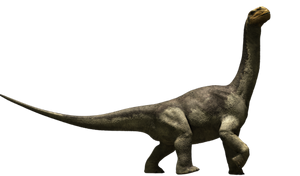|
Herbivores
| |
|
Species
|
Camarasaurus
|
|
Size
|
20 feet (6 meters) tall at the hips, 60 feet (18 meters) in length, 30-50 tons
|
|
Defense/weaponry
|
Superior size
Powerful legs Thrashing neck and tail |
|
Turf
|
USA, North America
|
|
Timespan
|
Late Jurassic 155-145 Ma
|
|
Appearances
|
First appearance: "Bloodiest Battle"
|
Camarasaurus ("chambered lizard") was a genus of quadrupedal, herbivorous dinosaurs. It was the most common of the giant sauropods to be found in North America. Its fossil remains have been found in the Morrison Formation of Colorado and Utah, dating to the late Jurassic Period (late Oxfordian to Tithonian stages), between [160-155]
This large sauropod made an appearance in "Bloodiest Battle", alongside other Jurassic dinosaurs.
Description[]
Much smaller than most of its fellow sauropods, the Camarasaurus could still grow to reach 20 feet tall at the hips, measure up to 18 meters (60 feet) long and weigh as much as 30-50 tons. It walked on four thick legs, with a long tail, neck and a small head with a blunt snout and large nostrils.There are other sauropods as well, like Apatosaurus, Diplodocus, Brachiosaurus, Chubutisaurus, Amphicoelias, Seismosaurus, and Ultrasaurus.
Fighting Style[]
Evidence has been found that Camarasaurus probably traveled in herds of older and younger members, perhaps so that adults could protect their young. Its most effective protection against attack was its superior size. Also like most sauropods, Camarasaurus could also use its long, massive tail in a fight, using it to strike away predators as big as Allosaurus, its most dangerous predator.
Diet[]
Camarasaurus had large spoon-shaped teeth, perfect for eating the plants that were its main diet. Its predators include the large meat-eating dinosaurs of the region, including Allosaurus.
Trivia[]
- Camarasaurus or chambered lizard gets its name from the fact that its vertebrae were hollow, in order to decrease the weight of its long backbone.
